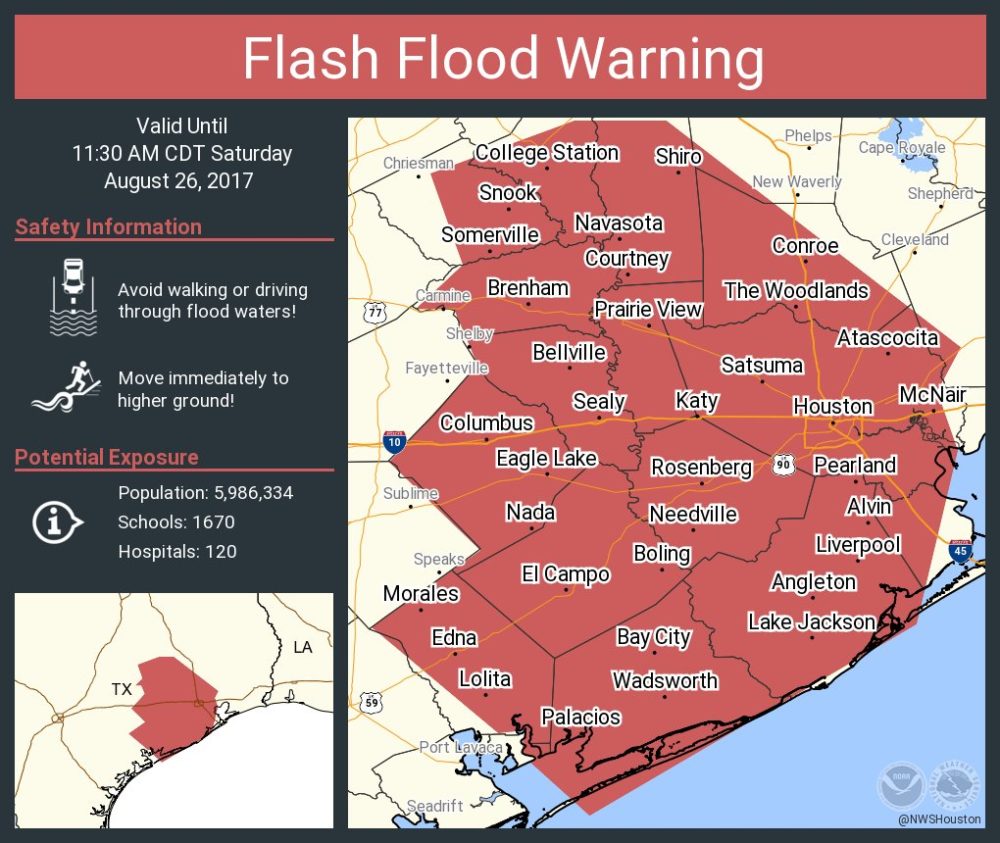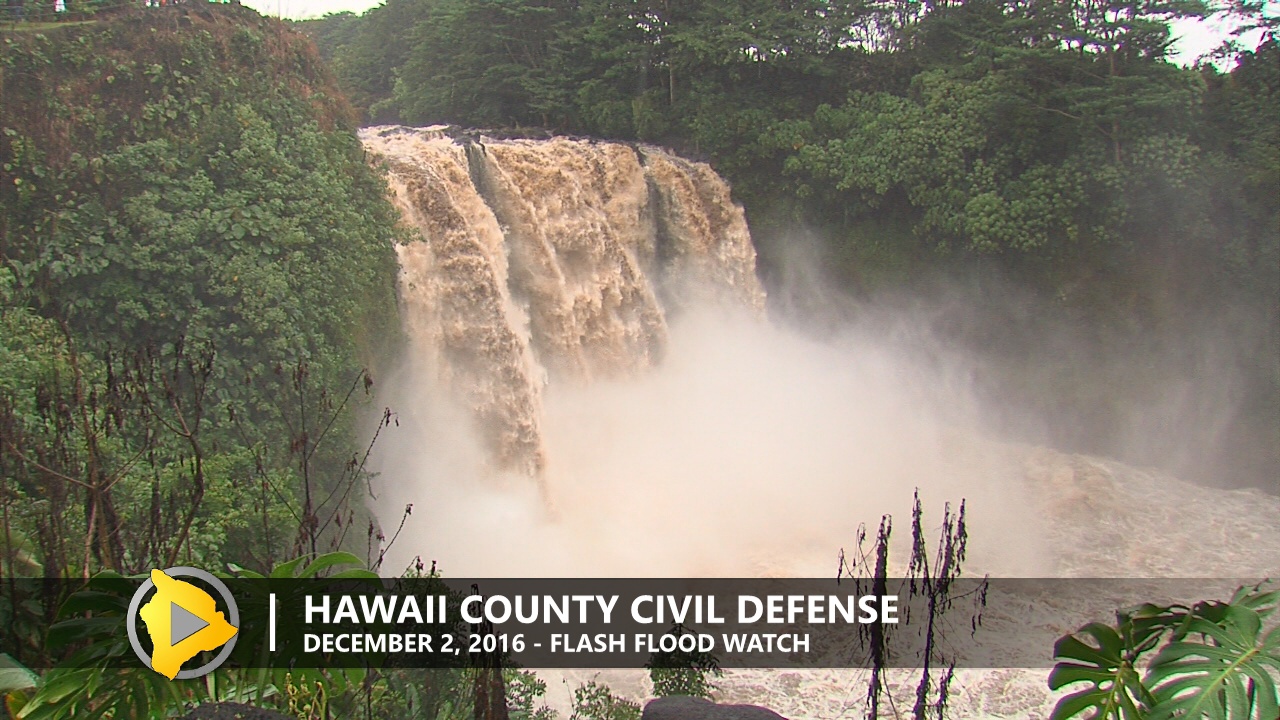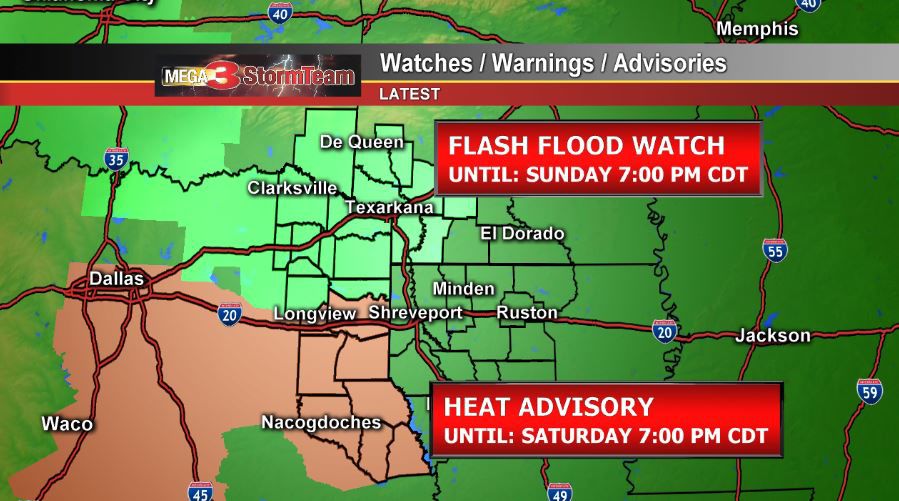Just like a severe thunderstorm watch, a tornado watch or a winter storm watch, a flash flood watch is not as urgent as a flash flood warning. It basically puts drivers, homeowners and public safety officials on notice that conditions are favorable for heavy rain to fall within a few hours. There are two types of alerts for flash floods which are issued by the National Weather Service.
A flood warning is issued when flooding is imminent or occurring. The intensity of the rain and the likelihood of greater damage will dictate whether the flood warning is elevated to a flash flood warning. During this warning, you are instructed to move to an area of higher ground if you're in a flood prone area due to the high likelihood of a flash flood happening. A flash flood is a sudden violent flood that can take from minutes to hours to develop.
In fact, a flash flood can occur so quickly that there isn't time to send out a flood warning alert. The National Weather Service issues flood watches and warnings for specific bodies of water, points along bodies of water, or on a county-by-county basis. When the agency issues a flood watch, flooding is a possibility within the next 24 to 48 hours because conditions are favorable for the respective weather event. A flood watch advisory indicates the possibility of a flood, but does not guarantee flooding will occur.
During a watch, it is a good idea to mind weather alerts or stay tuned to a radio or TV so you know when it's time to move to higher ground. It means that current weather conditions are favorable for flooding. While a watch does not a guarantee that a flash flood will occur, it is a very good indication that your community will experience severe weather.
A flood watch is issued when conditions are favorable for a specific hazardous weather event to occur, like extensive rain. A flash flood must occur within six hours of heavy rainfall or another event that means that flooding is imminent, according to the National Weather Service. In addition to heavy rain, a mudslide or dam and levee breaks can cause the National Weather Service to issue a flash flood warning.
We then immediately activate the Emergency Operations Center with the communications and warning, direction and control, and public information duties being staffed. The EOC's communications system is activated including the Amateur Radio Skywarn network. A flash flood is caused by excessive rainfall in a short period of time, generally less than 6 hours.
FLOOD WATCH means that flash flooding is possible within the watch area. FLASH FLOOD WARNING means that flash flooding is imminent or has been reported in the warning area and evacuation is advisable. When a flash flood warning is issued you may have 30-minutes or less to act. Therefore, you should pre-plan the actions you will take when a flood warning is issued. When rapid flooding from heavy rains or a dam failure is expected, the National Weather Service issues flash flood watches and warnings.
As with a flood warning, it's best to move to higher ground immediately after you learn of a flash flood warning. Flash floods can develop in minutes and are even possible in areas not immediately receiving rain. According to the National Weather Service, an Areal Flood Warning is issued for flooding that develops more gradually, usually from prolonged and persistent moderate to heavy rainfall. This results in a gradual ponding or buildup of water in low-lying, flood prone areas, as well as small creeks and streams.
The flooding normally occurs more than six hours after the rainfall begins, and may cover a large area. However, even though this type of flooding develops more slowly than flash flooding, it can still be a threat to life and property. An Areal Flood Warning is normally issued for flooding that develops more gradually, usually from prolonged and persistent moderate to heavy rainfall.
When a severe thunderstorm, tornado or flash flood watch is in effect, it means you should look for signs of dangerous weather and maintain access to the latest information. Sometimes a severe thunderstorm, tornado or flash flood can happen so quickly that warnings can't be issued in time. A flood or flash flood warning is issued when the hazardous weather event is imminent or already happening. A Flash Flood Warning is issued when a flash flood is imminent or occurring.
If you are in a flood prone area move immediately to high ground. It is even possible to experience a flash flood in areas not immediately receiving rain. If the local forecast includes a flood watch, then check your emergency kit to be sure that it is ready if one occurs.
Then, think through which roads have the highest elevations. If possible, plan to get out of low-lying areas before a flood warning is issued. If you are under evacuation notice, be sure to stay tuned to your local news sources and follow orders. If you cannot get out of a building, then head to the highest level and call 911. Flash Flood Warning – These warnings are issued when a heavy rain occurs, generally within a short amount of time. Flash floods are the number one weather-related causes of death, with over half of these deaths happening as a result of a vehicle-related drowning.
NOAA also states that a tornado watch, similar to a severe thunderstorm watch, means that conditions are favorable for severe thunderstorms to form and may be capable of producing a tornado. A tornado warning means a tornado is either occurring or imminent based on radar. The National Weather Service first issues a flood watch if there is time telling you that conditions may be right for sudden flooding.
You should prepare your emergency kit, especially if you are in an urban area, as the water has less room to sink into the ground. If the National Weather Service issues a flood warning, then take action immediately. Stay tuned to local news sources to see if a flooding evacuation is ordered and follow local authorities' recommendations. A flash flood watch means flash flooding is possible within the watch area. A flash flood warning means flash flooding is imminent or has been reported in the warning area. Areal flood warnings are the least concerning of the three types of flood warnings.
Areal flood warning in our area are usually issued when an area gradually picks up 1 to 2 inches of rain. It's a warning that indicates the potential for standing puddles of water on a roadway. Creeks and streams are also typically stressed in this occasion, as they may slowly grow out of their banks. An areal flood warning typically is issued when storms have decent movement and drop heavy rain in the process. A flood advisory is issued when flooding is not expected to be severe enough to warrant a warning. However, the rain may cause an inconvenience and could lead to property damage if not prepared for adequately.
It can stretch from a couple of counties to an entire NWS office forecast region. Flash flood watches are issued from individual NWS forecast offices. However, neighboring offices can issue their own respective flash flood watch and cover an entire region of the country. This is typical for widespread heavy rain events (such as a hurricane or stalled out front that doesn't move for days).
It's important to understand the difference between a flash flood warning and flash flood watch. It's also important to know that the definitions of these two alerts differ from the definitions of warnings and watches given for other severe-weather conditions, such as hurricanes. And you definitely shouldn't assume you know the difference between watch and warning just because you're are familiar with winter storms.
Since flash floods can happen so fast, unfortunately there isn't always time to send out a flash flood warning alert. If you do learn of a flash flood warning, seek higher ground immediately. Flash floods can develop even in areas where it doesn't rain when the warning was issued. A flash flood warning means a flash flood is imminent or occurring; take immediate action to protect life and property.
Conditions are favorable for flooding and flash flooding in and close to the watch area. Be aware of current conditions, especially if you live or work near a flood prone area or are near a river, creek or stream. Prepare to take immediate action to protect life and property. A Flood Watch is issued when conditions are favorable for a specific hazardous weather event to occur.
A Flood Watch is issued when conditions are favorable for flooding. If a flood watch or flash flood watch is issued, the National Weather Service says you should be prepared for the possibility of flooding and closely monitor the latest weather alerts in your area. River flood warnings are issued when a river is predicted to at least reach flood stage. In this instance, it typically takes several rounds of heavy rain over a few days or even weeks to potentially trigger these warnings. It can also happen when streams and rivers flow into another river and a more heavier, prolonged rain is present.
River flood warnings can last for extended amounts of time as it can take a while for a river to flood or to recede after flooding. If the river is in a significant flood stage, it can cause major damage to low lying areas as rivers flood into these areas. Most flash floods occur when there is a heavy amount of precipitation falling in an area and that water is then channeled through streams or narrow gullies.
It is possible to experience a flash flood without witnessing any rain. A flood watch is issued before a flood warning and indicates that flooding in your area is possible within the next 24 to 48 hours. While a flood watch does not mean flooding will likely occur, the conditions are favorable for a flood. If a flash flood warning contains this tag, heavy rain has been detected by Doppler Radar and may lead to flash flooding. A flash flood warning means a flash flood is either imminent or occurring. A warningindicates a severe thunderstorm and/or tornado has been spotted or is indicated on the NWS radar.
All those within the designated warning area should take cover immediately and remain there until the danger passes. The city of Frisco will activate the Outdoor Warning Sirens when severe weather, such as a tornado, threatens the community. If severe weather is approaching Frisco and the warning sirens are heard, seek shelter immediately and monitor TV and radio for further instructions. The National Weather Service said flash flood warnings are issued for flooding that normally occurs within six hours of heavy or intense rainfall. These warnings are issued to the community by BoM when severe weather is expected that is not directly related to severe thunderstorms or bushfires.
Examples of severe weather include damaging winds and flash flooding. When a watch is issued, you can go about normal activities, but should pay attention to the radio, Internet or TV for severe weather updates. Flooding can result from a number of weather systems including slow-moving or stationary frontal systems, inland moving tropical cyclones and intense summertime thunderstorms. These systems can produce flash flooding in low lying flood prone areas and along small creeks and streams, as well as river flooding along mainstreams. A Flash Flood Warning is issued for flooding that normally occurs within six hours of heavy or intense rainfall.
Intense rainfall can result in small creeks and streams quickly rising out of their banks. A Flood Warning is issued when the hazardous weather event is imminent or already happening. A Flood Warning is issued when flooding is imminent or occurring.
Flash flooding occurs when a large amount of rain comes down in a very short time period. Water has to find a place to go in these situations and danger can escalate quickly under these circumstances. Flash flooding is more likely in hilly areas as water flows downhill.
The problem is that water at higher elevations often merges and then gets collected at the bottom of a hill. A perfect example of serious flash flooding was back in August 2020 when heavy rain flooded Staunton. With flash flooding, storms produce rainfall rates of several inches a hour and have little movement. If a flood warning is in effect for your area, it's time to take action. Most flood fatalities happen because people underestimate the power of fast-moving water and heavy rain, or they're not prepared for an emergency situation.
A flood watch occurs when conditions are favorable for flooding. It doesn't mean that a flood will happen, but it's possible. This level of alerts is more severe than an advisory but less serious than a warning. A flash flood warning means a flash flood is imminent or occurring and you need to take action.
Depending on how the flash flood is being detected or reported, the National Weather Service will issue various warning tags within the flash flood warning. Heavy rainfall at any time of the year can over-saturate the ground and cause flooding, regardless of an area's elevation or average rainfall levels. In short, any area that receives precipitation has the potential to flood and experience flood damage to documents. Knowing the difference allows you to determine appropriate flood damage preparation steps and the possible need for document recovery services. A flood warning or a flash flood warning is more urgent than a watch, so drivers and pedestrians should avoid flooded streets and move to higher ground if a warning is issued.
— Tornado watches and flash flood warnings have been issued for parts of the Tri-State Area as remnants of Ida blow in with severe weather. Nebraska is in the middle of tornado alley and each year the state averages 35 tornadoes. Stay tuned to the media when the watches are sounded and be prepared to seek shelter if a tornado warning is issued in your area.




























No comments:
Post a Comment
Note: Only a member of this blog may post a comment.